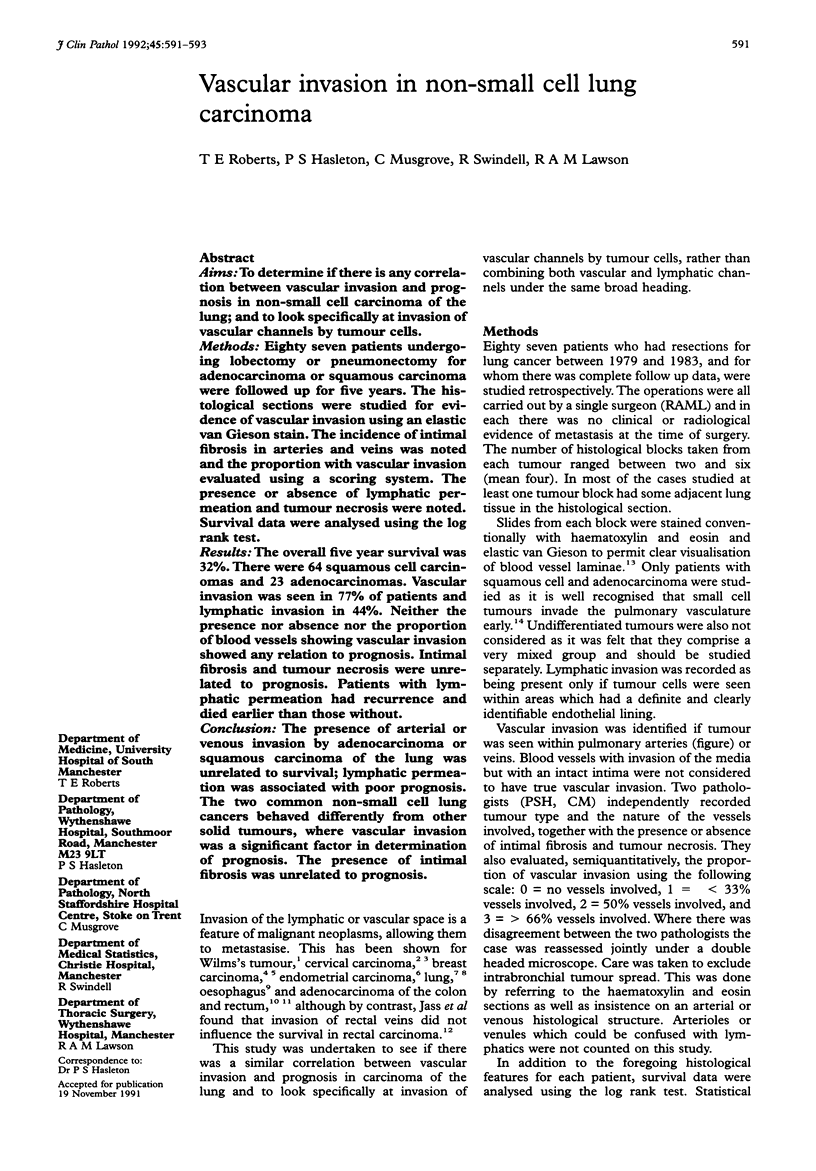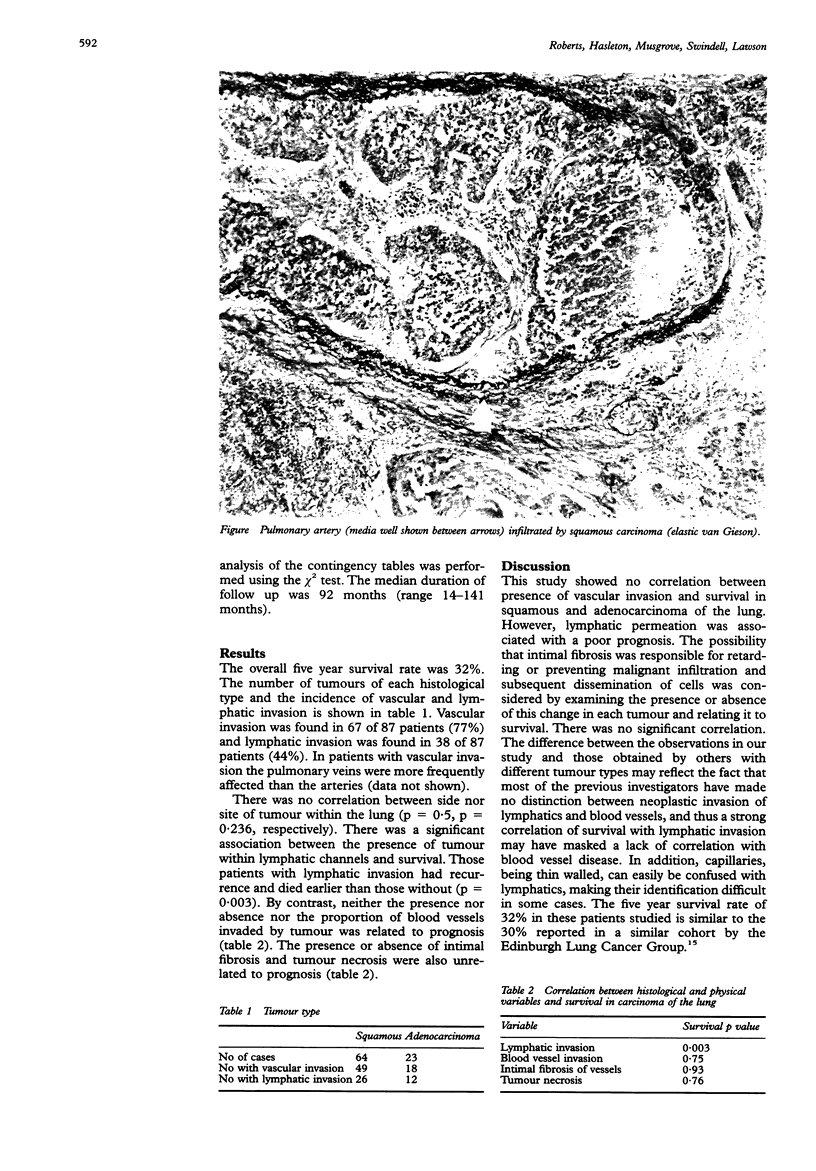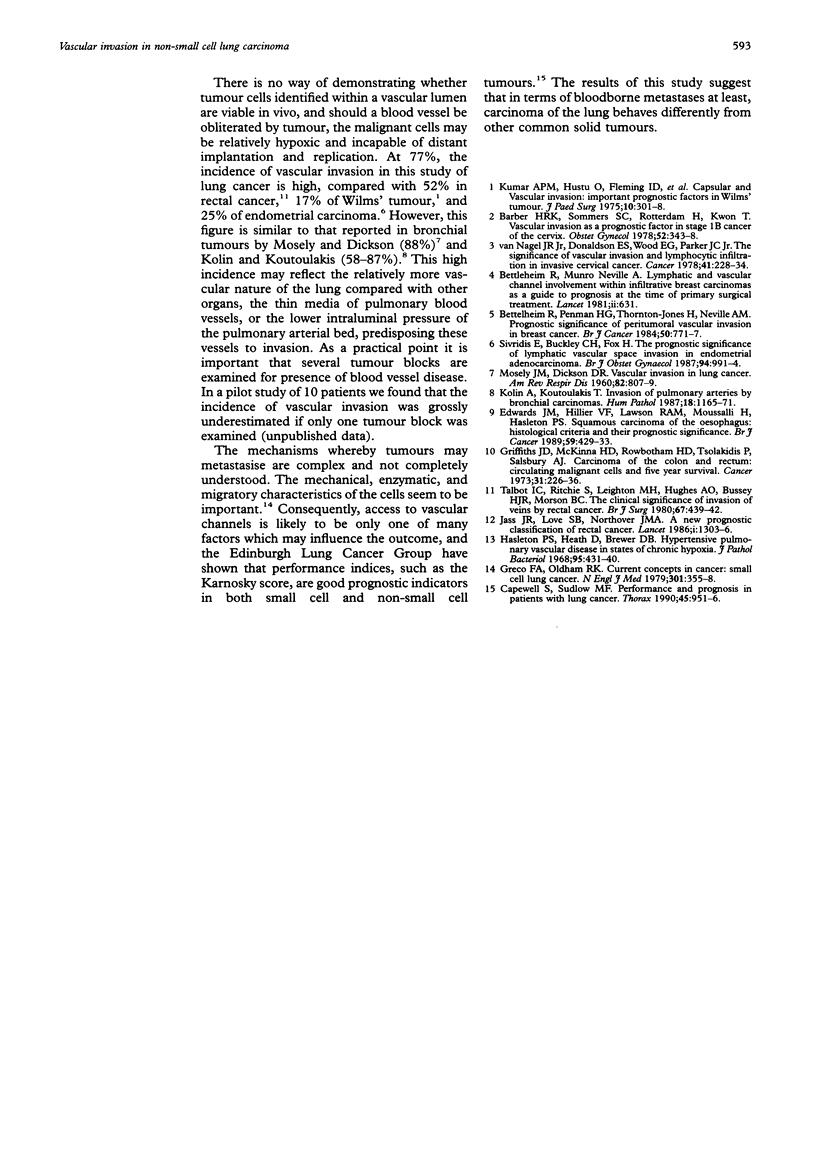Abstract
AIMS: To determine if there is any correlation between vascular invasion and prognosis in non-small cell carcinoma of the lung; and to look specifically at invasion of vascular channels by tumour cells. METHODS: Eighty seven patients undergoing lobectomy or pneumonectomy for adenocarcinoma or squamous carcinoma were followed up for five years. The histological sections were studied for evidence of vascular invasion using an elastic van Gieson stain. The incidence of intimal fibrosis in arteries and veins was noted and the proportion with vascular invasion evaluated using a scoring system. The presence or absence of lymphatic permeation and tumour necrosis were noted. Survival data were analysed using the log rank test. RESULTS: The overall five year survival was 32%. There were 64 squamous cell carcinomas and 23 adenocarcinomas. Vascular invasion was seen in 77% of patients and lymphatic invasion in 44%. Neither the presence nor absence nor the proportion of blood vessels showing vascular invasion showed any relation to prognosis. Intimal fibrosis and tumour necrosis were unrelated to prognosis. Patients with lymphatic permeation had recurrence and died earlier than those without. CONCLUSION: The presence of arterial or venous invasion by adenocarcinoma or squamous carcinoma of the lung was unrelated to survival; lymphatic permeation was associated with poor prognosis. The two common non-small cell lung cancers behaved differently from other solid tumours, where vascular invasion was a significant factor in determination of prognosis. The presence of intimal fibrosis was unrelated to prognosis.
Full text
PDF


Images in this article
Selected References
These references are in PubMed. This may not be the complete list of references from this article.
- Barber B. R., Sommers S. C., Rotterdam H., Kwon T. Vascular invasion as a prognostic factor in stage IB cancer of the cervix. Obstet Gynecol. 1978 Sep;52(3):343–348. [PubMed] [Google Scholar]
- Bettelheim R., Neville A. M. Lymphatic and vascular channel involvement within infiltrative breast carcinomas as a guide to prognosis at the time of primary surgical treatment. Lancet. 1981 Sep 19;2(8247):631–631. doi: 10.1016/s0140-6736(81)92760-4. [DOI] [PubMed] [Google Scholar]
- Bettelheim R., Penman H. G., Thornton-Jones H., Neville A. M. Prognostic significance of peritumoral vascular invasion in breast cancer. Br J Cancer. 1984 Dec;50(6):771–777. doi: 10.1038/bjc.1984.255. [DOI] [PMC free article] [PubMed] [Google Scholar]
- Capewell S., Sudlow M. F. Performance and prognosis in patients with lung cancer. The Edinburgh Lung Cancer Group. Thorax. 1990 Dec;45(12):951–956. doi: 10.1136/thx.45.12.951. [DOI] [PMC free article] [PubMed] [Google Scholar]
- Chouza C., Scaramelli A., Caamaño J. L., De Medina O., Aljanati R., Romero S. Parkinsonism, tardive dyskinesia, akathisia, and depression induced by flunarizine. Lancet. 1986 Jun 7;1(8493):1303–1304. doi: 10.1016/s0140-6736(86)91223-7. [DOI] [PubMed] [Google Scholar]
- Edwards J. M., Hillier V. F., Lawson R. A., Moussalli H., Hasleton P. S. Squamous carcinoma of the oesophagus: histological criteria and their prognostic significance. Br J Cancer. 1989 Mar;59(3):429–433. doi: 10.1038/bjc.1989.87. [DOI] [PMC free article] [PubMed] [Google Scholar]
- Greco F. A., Oldham R. K. Current concepts in cancer: small-cell lung cancer. N Engl J Med. 1979 Aug 16;301(7):355–358. doi: 10.1056/NEJM197908163010704. [DOI] [PubMed] [Google Scholar]
- Griffiths J. D., McKinna J. A., Rowbotham H. D., Tsolakidis P., Salsbury A. J. Carcinoma of the colon and rectum: circulating malignant cells and five-year survival. Cancer. 1973 Jan;31(1):226–236. doi: 10.1002/1097-0142(197301)31:1<226::aid-cncr2820310130>3.0.co;2-m. [DOI] [PubMed] [Google Scholar]
- Hasleton P. S., Heath D., Brewer D. B. Hypertensive pulmonary vascular disease in states of chronic hypoxia. J Pathol Bacteriol. 1968 Apr;95(2):431–440. doi: 10.1002/path.1700950213. [DOI] [PubMed] [Google Scholar]
- Kolin A., Koutoulakis T. Invasion of pulmonary arteries by bronchial carcinomas. Hum Pathol. 1987 Nov;18(11):1165–1171. doi: 10.1016/s0046-8177(87)80386-6. [DOI] [PubMed] [Google Scholar]
- Kumar A. P., Hustu O., Fleming I. D., Wrenn E. L., Jr, Pratt C. B., Johnson W., Pinkel D. Capsular and vascular invasion: important prognostic factors in Wilms' tumor. J Pediatr Surg. 1975 Jun;10(3):301–309. doi: 10.1016/0022-3468(75)90092-5. [DOI] [PubMed] [Google Scholar]
- MOSELY J. M., DICKSON D. R. Vascular invasion in lung cancer. Clinical-pathologic significance. Am Rev Respir Dis. 1960 Dec;82:807–809. doi: 10.1164/arrd.1960.82.6.807. [DOI] [PubMed] [Google Scholar]
- Sivridis E., Buckley C. H., Fox H. The prognostic significance of lymphatic vascular space invasion in endometrial adenocarcinoma. Br J Obstet Gynaecol. 1987 Oct;94(10):991–994. doi: 10.1111/j.1471-0528.1987.tb02275.x. [DOI] [PubMed] [Google Scholar]
- Talbot I. C., Ritchie S., Leighton M. H., Hughes A. O., Bussey H. J., Morson B. C. The clinical significance of invasion of veins by rectal cancer. Br J Surg. 1980 Jun;67(6):439–442. doi: 10.1002/bjs.1800670619. [DOI] [PubMed] [Google Scholar]
- van Nagell J. R., Jr, Donaldson E. S., Wood E. G., Parker J. C., Jr The significance of vascular invasion and lymphocytic infiltration in invasive cervical cancer. Cancer. 1978 Jan;41(1):228–234. doi: 10.1002/1097-0142(197801)41:1<228::aid-cncr2820410131>3.0.co;2-6. [DOI] [PubMed] [Google Scholar]



